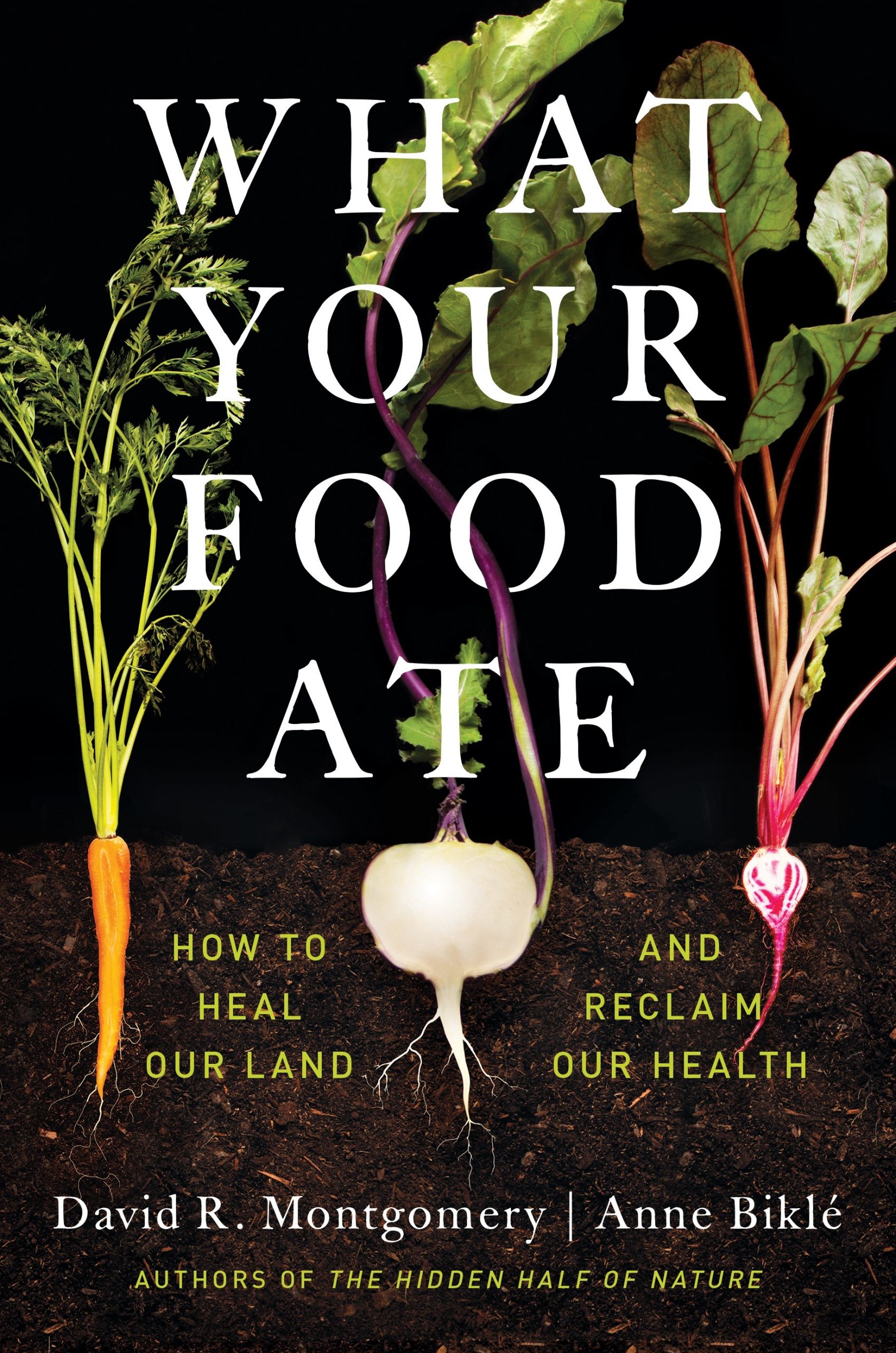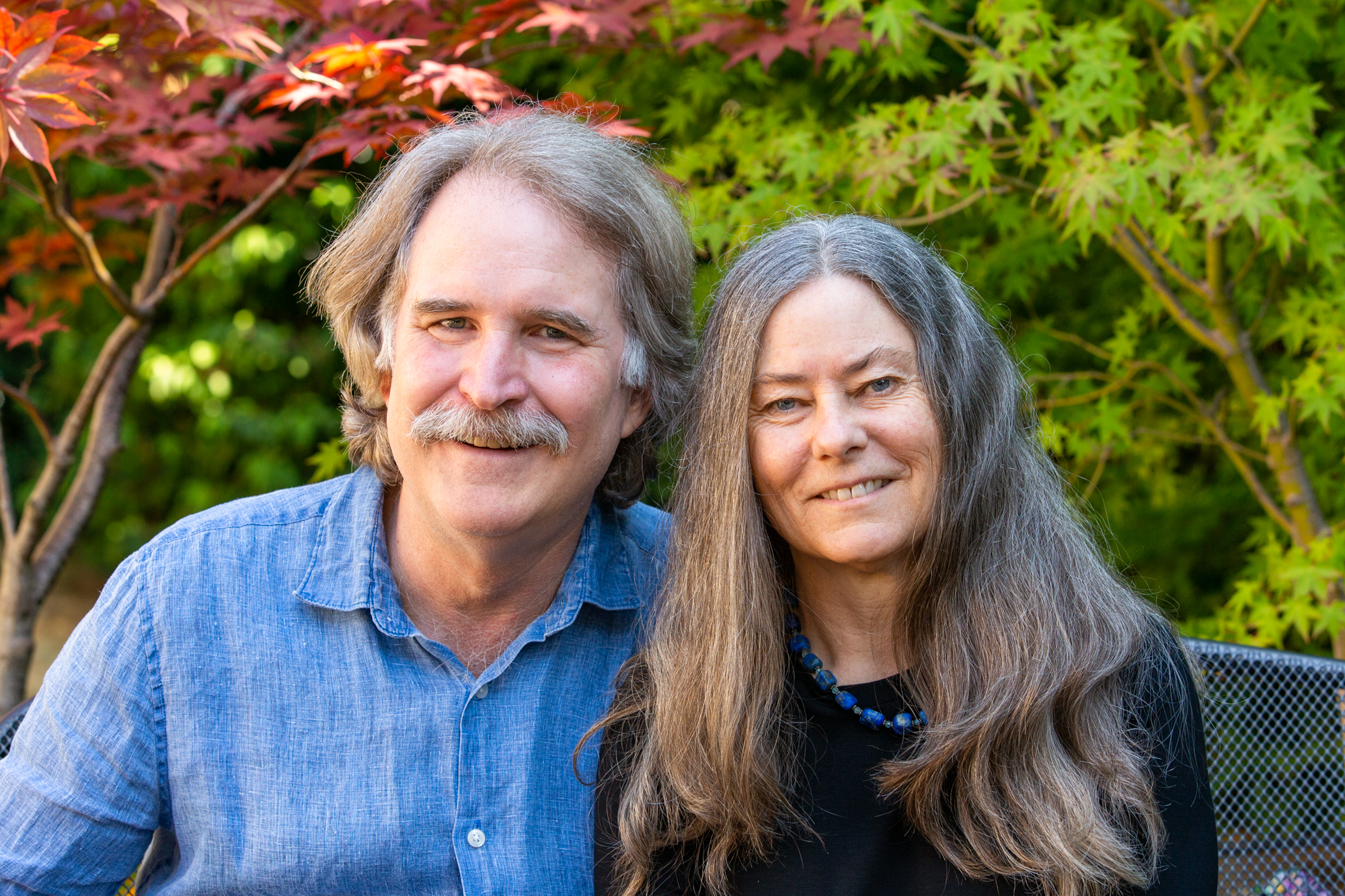We all know that diet greatly influences health. In What Your Food Ate: How to Heal Our Land and Reclaim Our Health, geologist David R. Montgomery and biologist Anne Biklé show how the crises of human and planetary health are rooted—literally—in the soil on our farms and ranches, and how we can solve them by changing how we raise our food.
What led you to write What Your Food Ate?
Anne: I think was inevitable that we would end up where we did because we called our other three books the “Dirt Trilogy.” The first one, Dirt, is about the destruction of soil that’s happened over time with what farming does. It puts soil—and thereby humanity—in this real predicament. The Hidden Half of Nature was about how soil and the human body work and how microbiomes are important to that, which is a new insight and understanding. Growing a Revolution looked at how farmers were using the science in The Hidden Half to solve the problems from Dirt. This book asks the bigger question of what are the implications of this human endeavor we call agriculture, and what we know about its effects on soil, crops, animals, and us.
David: What Anne and I realized when I got through with Growing a Revolution is there’s still the lingering question of what regenerative practices mean for the human diet, and the connection between soil health and human health. And what we’re really trying to tackle with this book is that connection: what is the line that runs from soil health to human health?
You mentioned in the book the focus on yields of agricultural crops has reduced the nutritional value of those crops. Can you talk a little bit about that?
David: The focus on yields in the late 20th century was driven by the desire to feed the world, which is a good thing. But there are some inadvertent side effects that came with the methods through which we achieved that during the Green Revolution.
There’s an effect in agriculture called the dilution effect. It’s a simple idea, that if you have, say, a wheat plant that’s taking up a certain amount of iron from the soil and its roots, it then distributes that iron through twice as much grain that’s going to its seeds. For a high yielding variety, each kernel gets half as much iron. That’s the dilution. There’s solid evidence that for many mineral micronutrients, the dilution effect has been real in terms of our higher yielding crop varieties. We can grow higher yields but with lower micronutrient concentrations. Micronutrients tend to be important for both plant health and human health.
The other really big difference is in terms of the phytochemical content, which is greatly affected by the way that we farm as well. We want micronutrients and phytochemicals in our diet because they help promote our health.
You conducted a study comparing crops grown on regenerative farms with those grown on conventional farms. Tell me about that.
David: We wanted to run a study that we couldn’t find in the literature, which is a direct comparison of conventional versus regenerative farms in terms of what the health of the soil is like on those different styles of farms. And what that means for the nutritional value of crops that are grown on them.
We had the budget to compare 10 pairs of farms across the U.S. The regenerative farm paired with the conventional farm in the same area with the same soil growing crops in the same year.
We tested the soils, the mineral content, and three classes of phytochemicals: carotenoids, phytosterols, and polyphenols. We added a suite of vitamins as well.
What we found is that on the regenerative farms, which are farms that have been farmed using a combination of no-till with cover crops and a diversity of crops for at least five and up to 10 years, the soil organic matter content was on average about twice as high.
The regenerative farms had more fertile, healthier, and more carbon rich soil. On the regenerative farms, on average, there’s a number of mineral elements that were higher. And across the board, phytochemicals were 16% to 25% higher in the regenerative crops.
This is a small sample size asking the question: is there something to the idea that soil health may correlate with differences in what ends up in the food? This provides a preliminary direct comparison that suggests that, yes, there is probably something to it.
 Do you see more studies like this being done to link soil health with more nutritious foods?
Do you see more studies like this being done to link soil health with more nutritious foods?
David: We’d certainly like to see a lot more studies looking at that. What you find in the literature are comparisons of organic versus conventional. We went back and read every study we could find about those kinds of comparisons. What we concluded is that there doesn’t seem to be a whole lot of evidence that supports consistent differences in the macronutrient amounts in organic versus conventional foods. But there does seem to be significant differences in the micronutrient contents. That parallels what we found for regenerative versus conventional. In almost every comparison study we found, there’s big differences in the phytochemical contents between organic and conventional foods.
It suggests that the real underlying metric that we ought to be comparing things on is soil health. I think one of the key messages that we would like to convey, based on our research, is that soil health is the right lens to think about it.
When comparing nutritional values of organic versus conventional crops, is it best to see it through the lens of soil health?
David: Well, when looking at the effect of farming practices on the nutritional value of foods, it’s useful to use soil health as the lens, all other things being equal. An organic farmer is probably going to have better soil health than a conventional farmer. But all other things are not always equal. Organic farmers might be tilling too much for example. And you could have some conventional farmers who are hardly using any agrochemicals, even though they do use some.
Anne: If you set aside what a farmer calls their system or what somebody else calls their system, you just look at soil because soil tells a story of what the practices are. If you’ve got a soil that has a lot of organic matter, the kinds of soil life that we know are on the whole more beneficial than harmful. If you can interpret the qualities and characteristics of soil relative to its health and its function, that’s almost a better way to look at it than what any given farmer decides to name their system.
It’s not just about what to eat, it’s just as important about how we grow it?
Anne: I think the simplest way to put the main message that we’re hoping to get across in the book is that if it’s good for the land, for the animal, and the soil microbiome, it’s going to produce foods for the human diet that our bodies thrive on and need.
Do you see tillage as a big problem with organic agriculture?
David: If you look at soil life as the engine of soil health, disturbing that life is a negative. There’s two styles of disturbance, chemical disturbance and physical disturbance. Tillage is the physical disturbance in that it breaks up microbial fungal networks. It accelerates the oxidation of soil organic matter. It’s a good means of weed control but it has these other downsides.
Chemical disturbance has a whole other set of effects in terms of poisoning or disrupting the soil microbiome. While herbicides can be great for weed control, they have this chemical disturbance of the life in the soil.
What you would recommend is for organic farmers to minimize the physical disturbance of the soil to the degree they can and for conventional farmers to minimize the chemical disturbance. The idea of going no-till, but using a ton of herbicide—that is not regenerative.
What do you think needs to be done to encourage more farmers to adopt regenerative practices?
Anne: I think it’s markets. Consumers can drive what farmers grow. In part that is what has happened with organic. It’s been consumer demand for organic food.
If consumers are educated about soil health and asking questions about soil health practices at their grocery store, co-op, or farmers’ market, farmers are going to know people are interested in that.
David: There are two ways to encourage the promulgation of more regenerative agriculture in both conventional and organic circles. One is if it makes economic sense for farmers, a certain number of them are going to be doing that.
And if the health promoting compounds in regeneratively grown foods are at higher levels then conventionally grown foods, which they appear to be, then one could anticipate enhanced consumer demand.
What do you think the impact will be on public health and the environment with the widespread adoption of regenerative practices?
Anne: I think there’s huge potential for regenerative agriculture to positively impact public health, and lord knows we need that these days. If pandemics and infectious diseases are going to become the new norm, then we need properly functioning immune systems to deal with those. Because of all the connections between diet and immunity and our overall health, it’s just imperative that we move toward a form of agriculture that produces phytochemicals, micronutrients, and a healthy balance of fats. Because all of those things are a big part of what allows our body to maintain health.
David: You could paint two visions for the future of agriculture. One would be continuing the conventional path, the degenerative path. Degrading the land further and not really doing anything to address the micronutrient phytochemicals. The other one is if regenerative farming becomes conventional farming. It’s going to help us address a whole range of environmental and human health problems—from increasing soil organic matter, which will help with the climate issue, to reducing nitrate runoff, which will help with the offsite pollution issue, and reducing pesticide use, which will help farmers and farm workers increase the micronutrient phytochemical contents of food. That ought to help public health across the board. The awareness of soil health is going to leave people, livestock, the environment, and the planet all better off.





